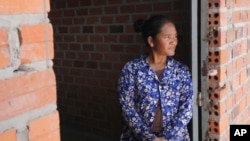It has been more than a year since Yem Srey Pin moved with her family from the village where she was born to the dusty new settlement of Run Ta Ek, about 25 kilometers away.
She is one of about 5,000 families relocated by Cambodian authorities from the sprawling archaeological site. Cambodian authorities are implementing a plan that Amnesty International has condemned as a “serious violation of international human rights law”. Another 5,000 families still need to be relocated.
The accusations drew strong attention from UNESCO and a fierce rebuttal from Cambodian authorities, who said all they were doing was protecting the heritage site from illegal squatters.
Yem Srey Pin’s one-room home is much nicer than the makeshift tent she lived in when she first arrived with her husband and five children, which offered little protection from the monsoon rains and blew over in the wind.
Their 600 square meters of land is much larger than the 90 square meters they illegally occupy in the Angkor ruins village of Khvean.
But the 35-year-old is also heavily in debt from building new homes. Her husband found there were fewer construction sites nearby, wages were lower, and there were no wild fruits or vegetables for her to pick, or rice paddies to collect crabs to sell at her mother’s stall.
“I haven’t been able to save any money or make any money in over a year here,” she said.
The Angkor ruins are one of the largest archaeological sites in the world, located in northwest Cambodia, covering an area of approximately 400 square kilometers. It contains the remains of the capital of the Khmer Empire from the 9th to the 15th centuries, including the temples of Angkor Wat.
When it was inscribed on the World Heritage List in 1992, it was named a “living heritage site” where local residents preserve ancestral traditions and cultural practices that have disappeared elsewhere.
Still, UNESCO noted at the time that Angkor faced “double pressure” from some 100,000 residents of 112 historic settlements who “continuously try to expand their living area”, as well as encroachment from the nearby town of Siem Reap.
Cambodia’s answer is to develop a program to attract the 10,000 families squatting illegally in the area to resettle in Run Ta Ek and another site, and to encourage some families in the 112 historic settlements to relocate as their families grow.
“The number of people is increasing, and that includes illegal immigrants,” said Long Kosal, spokesman for APSARA, the Cambodian agency that manages the Angkor Wat site. “What we do is provide an option.”
Cambodia began moving people to Run Ta Ek in 2022, providing those who voluntarily left their homes in the Angkor region with land, two months’ supply of canned food and rice, tarps and 30 corrugated metal sheets to build a home. Benefits also include a poverty card, essentially a state welfare program that provides them with about 310,000 riel (about $75) per month for 10 years.
In a November report, Amnesty International questioned how voluntary the evictions actually were, saying many people they interviewed had been threatened or forced to move and that the evictions were more of a “disguised forced eviction”.
The rights group quoted former Prime Minister Hun Sen’s speech in which he said people “must either leave the Angkor ruins as soon as possible and receive some form of compensation, or be evicted later and receive nothing”.
Amnesty International also pointed to Hun Sen’s track record, saying that under his long rule, Cambodian authorities were responsible for several forced evictions elsewhere that it said “constituted serious human rights violations.” The report states that Rundayi Village has problems such as dirt roads, insufficient drainage, and poor sanitary conditions, and has failed to fulfill its international obligations under human rights treaties to provide people with adequate housing.
Things have changed now: houses with outbuildings have been built, roads have been paved and sewers installed. Water is provided by an original hand pump made of blue PVC pipes and has electricity.
There is a school, a health center, a temple; bus routes have been added and a market area has been established, but it is not yet operational, Longkosar said.
But Amnesty International insists there are major concerns.
Among other things, families have had to take on heavy debt to build even basic homes and there are few jobs available, said Montese Ferrer, head of Amnesty International’s research team investigating resettlement at Angkor Wat.
“They had a clear source of income at the time – tourism – but also other sources of income related to the Angkor ruins,” she said. “They are now at least 30 minutes away from the site and no longer have access to those resources.”
UNESCO has brought forward Cambodia’s timetable for submitting a report on the state of conservation of the Angkor ruins after Amnesty International published a scathing report and specifically called for the allegations to be addressed.
In a report submitted to UNESCO in March, Cambodia said the relocation did not violate any international law but was simply relocating people involved in the “illegal occupation of the heritage site” and that many of the people in Rundayet were now property owners. For the first time in my life.
UNESCO said it would not comment on the matter until it analyzes Cambodia’s response.
The AP cited previous comments by Lazar Elondu Asomou, director of the UNESCO World Heritage Center, who stressed that the agency “has always categorically rejected the use of forced evictions as a tool to manage inscriptions on the World Heritage List.”
Yem Srey Pin said that although Run Ta Ek has slowly improved since arriving here in February 2023 and her new house will be able to pay off the loan soon, she would rather return to her village if she could.
But with almost all of the village’s 400 families moved out, Yem Srey Pin says there is nothing left for her.
“I can’t live alone in my old village,” she said.
Follow us on Google news ,Twitter , and Join Whatsapp Group of thelocalreport.in

